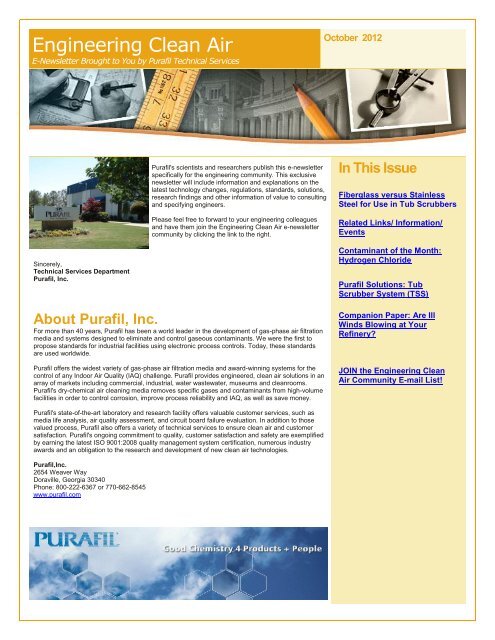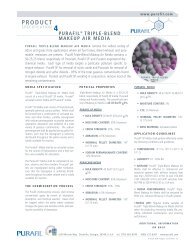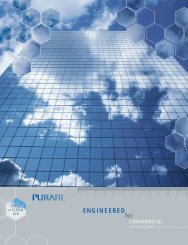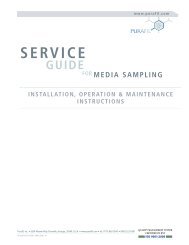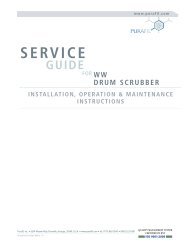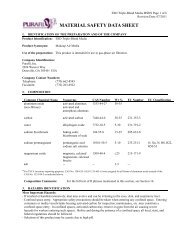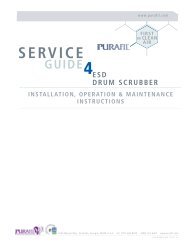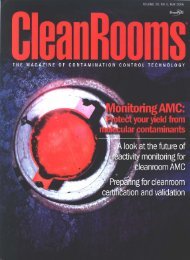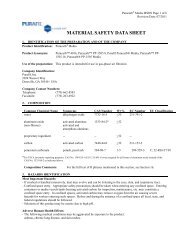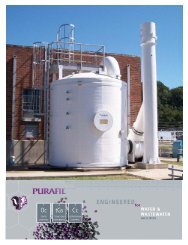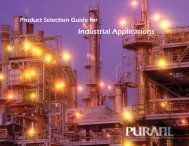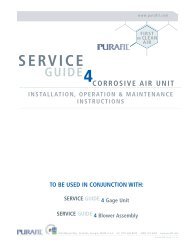Engineering Clean Air - Purafil
Engineering Clean Air - Purafil
Engineering Clean Air - Purafil
You also want an ePaper? Increase the reach of your titles
YUMPU automatically turns print PDFs into web optimized ePapers that Google loves.
<strong>Engineering</strong> <strong>Clean</strong> <strong>Air</strong><br />
E-Newsletter Brought to You by <strong>Purafil</strong> Technical Services<br />
Sincerely,<br />
Technical Services Department<br />
<strong>Purafil</strong>, Inc.<br />
<strong>Purafil</strong>'s scientists and researchers publish this e-newsletter<br />
specifically for the engineering community. This exclusive<br />
newsletter will include information and explanations on the<br />
latest technology changes, regulations, standards, solutions,<br />
research findings and other information of value to consulting<br />
and specifying engineers.<br />
Please feel free to forward to your engineering colleagues<br />
and have them join the <strong>Engineering</strong> <strong>Clean</strong> <strong>Air</strong> e-newsletter<br />
community by clicking the link to the right.<br />
About <strong>Purafil</strong>, Inc.<br />
For more than 40 years, <strong>Purafil</strong> has been a world leader in the development of gas-phase air filtration<br />
media and systems designed to eliminate and control gaseous contaminants. We were the first to<br />
propose standards for industrial facilities using electronic process controls. Today, these standards<br />
are used worldwide.<br />
<strong>Purafil</strong> offers the widest variety of gas-phase air filtration media and award-winning systems for the<br />
control of any Indoor <strong>Air</strong> Quality (IAQ) challenge. <strong>Purafil</strong> provides engineered, clean air solutions in an<br />
array of markets including commercial, industrial, water wastewater, museums and cleanrooms.<br />
<strong>Purafil</strong>'s dry-chemical air cleaning media removes specific gases and contaminants from high-volume<br />
facilities in order to control corrosion, improve process reliability and IAQ, as well as save money.<br />
<strong>Purafil</strong>'s state-of-the-art laboratory and research facility offers valuable customer services, such as<br />
media life analysis, air quality assessment, and circuit board failure evaluation. In addition to those<br />
valued process, <strong>Purafil</strong> also offers a variety of technical services to ensure clean air and customer<br />
satisfaction. <strong>Purafil</strong>'s ongoing commitment to quality, customer satisfaction and safety are exemplified<br />
by earning the latest ISO 9001:2008 quality management system certification, numerous industry<br />
awards and an obligation to the research and development of new clean air technologies.<br />
<strong>Purafil</strong>,Inc.<br />
2654 Weaver Way<br />
Doraville, Georgia 30340<br />
Phone: 800-222-6367 or 770-662-8545<br />
www.purafil.com<br />
October 2012<br />
In This Issue<br />
Fiberglass versus Stainless<br />
Steel for Use in Tub Scrubbers<br />
Related Links/ Information/<br />
Events<br />
Contaminant of the Month:<br />
Hydrogen Chloride<br />
<strong>Purafil</strong> Solutions: Tub<br />
Scrubber System (TSS)<br />
Companion Paper: Are Ill<br />
Winds Blowing at Your<br />
Refinery?<br />
JOIN the <strong>Engineering</strong> <strong>Clean</strong><br />
<strong>Air</strong> Community E-mail List!
Fiberglass versus Stainless Steel for Use in Tub Scrubbers<br />
Many corrosion and odor control applications require the<br />
use of large amounts of dry-scrubbing media for optimum<br />
control of chemical contaminants. These systems provide<br />
extremely high contaminant removal efficiency and media<br />
service life insuring optimum system performance.<br />
These filtration systems can be made from a number of<br />
different materials depending on the application and<br />
customer requirements. Most common are aluminum,<br />
stainless steel and fiberglass. Fiberglass (or fiber)<br />
reinforced plastics (FRP) are composite structural materials<br />
containing high strength fibrous embedded reinforcements<br />
that develop mechanical properties greatly superior to the<br />
base resin. There are many plastic materials that can be<br />
used in FRP, and <strong>Purafil</strong> uses polyester due to its superior<br />
properties.<br />
Tub scrubbers made from fiberglass reinforced polyester<br />
can offer significant benefits over metal vessels<br />
manufactured from materials such as aluminum and<br />
stainless steel. There are generally three ways in which FRP<br />
has an advantage over metals:<br />
1. Weight: generally a substantial reduction weight in can be achieved due to the lower density of<br />
FRP versus stainless steel or aluminum. When compared to a stainless steel system, one made<br />
from FRP would have less than one-quarter the weight. This equates to lower shipping and<br />
handling costs - especially for transcontinental or transoceanic shipments. Most <strong>Purafil</strong> FRP air<br />
filtration systems can be moved with forklifts and would not require hiring a crane to do the lifting<br />
and placement.<br />
2. Fewer Parts: Consolidating many parts of an assembly into one part is a major benefit gained by<br />
using FRP. Part consolidation reduces part count, fasteners and assembly time. This in turn<br />
significantly reduces maintenance requirements.<br />
3. Customization: The fiber/resin mix and stacking sequence can be adjusted to meet specific<br />
stiffness/strength/manufacturing requirements. <strong>Purafil</strong> has use FRP in the construction of air<br />
filtration systems containing as much as 25,000 pounds of media.<br />
Weight savings is often mentioned as the single most important advantage of FRP but the reduction in the<br />
number of parts and the cost savings associated with it is often a more significant factor. FRP vessels can<br />
be fabricated as a single unit whereas metal vessels often consist of multiple parts that have to be welded<br />
and inspected. If done improperly, welding stainless steel can produce weak points in the systems which<br />
are oftentimes where corrosive attack can begin.<br />
In addition to the advantages highlighted above, FRP is comparable or superior to metals in several others<br />
ways.<br />
FRP provides excellent corrosion and chemical resistance compared to metals such as aluminum<br />
and painted or galvanized steel and is very comparable to that of stainless steel. With FRP<br />
construction, system maintenance is virtually eliminated.<br />
FRP provides optimal dielectric strength as an electrical insulator versus the electrical conductivity<br />
of steel. FRP systems do not require grounding to ensure safety against direct or indirect contact.<br />
FRP is significantly more cost effective than stainless steel and is very competitive with other<br />
metals.
FRP is extremely easy to drill, cut, and punch compared to all metals. Retrofitting is essentially<br />
eliminated because of the ability to modify FRP vessels using knock-out panels. If modifications<br />
are required, FRP components generally do not require special tools or fixtures and work can be<br />
performed on site with minimum downtime.<br />
FRP systems are lightweight and easy to handle compared to metal systems.<br />
Our comparison of FRP to stainless steel and aluminum is summarized in Table 1 below.<br />
Table 1. Comparison of FRP to Metals Commonly Used in Industrial Applications<br />
Fiberglass reinforced<br />
polyester (FRP) Stainless Steel<br />
Physical strength<br />
Strong<br />
High strength<br />
Acids: recommended Acids: recommended<br />
in most applications in most applications<br />
Bases: recommended Bases: recommended<br />
in most applications in most applications<br />
Solvents:<br />
Solvents:<br />
recommended<br />
recommended<br />
Corrosion resistance<br />
in most applications in most applications<br />
Chemical resistance<br />
Excellent<br />
Excellent<br />
Relative cost<br />
Low<br />
High<br />
Impact resistance<br />
Moderate<br />
High<br />
Tensile strength<br />
Moderate<br />
High<br />
Ease of drilling, punching, and cutting<br />
Very Easy<br />
Extremely hard<br />
Dielectric strength<br />
Electrical insulator Electrical conductor<br />
Thermal conductivity<br />
Thermal insulator Thermal conductor<br />
Weight, lb/ft 3<br />
111<br />
489<br />
Aluminum<br />
Strong<br />
Acids: limited use<br />
in most applications<br />
Bases: very limited use<br />
in most applications<br />
Solvents: recommended<br />
in most applications<br />
Good<br />
Moderate<br />
Moderate to high<br />
High<br />
Hard<br />
Electrical conductor<br />
Thermal conductor<br />
169<br />
FRP and stainless steel are given an "Excellent" for chemical resistance. This is an important factor to<br />
consider when deciding on choice of materials for an air filtration system that is to be used in a corrosive<br />
(aggressive) environment. Although generally considered to be a corrosion-resistant material, stainless<br />
steel can experience corrosion that can be described in a variety of technical terms that include: galvanic<br />
corrosion, pitting, intergranular corrosion, stress corrosion, cracking, erosion corrosion, fretting,<br />
concentrated cell or crevice corrosion, and selective leaching. Additional general information on the<br />
corrosion of stainless steel is shown on the following page.<br />
In summary, <strong>Purafil</strong> air filtration systems made from FRP are:<br />
Equal to stainless steel in corrosion and chemical resistance, and far better than carbon steel<br />
Strong enough to hold up under extreme conditions<br />
Lighter and easier to transport and handle<br />
Less expensive to ship<br />
Much easier to punch, drill or saw<br />
Non conductive – an electrical insulator rather than electrical conductor<br />
<strong>Purafil</strong> FRP systems also outperform other non metallic alternatives in areas such as:<br />
Chemical resistance<br />
Protection against degradation due to UV exposure<br />
Resistance to extreme temperatures<br />
Flame retardant properties<br />
Because of its physical, chemical, and mechanical properties, there are many application where fiberglass<br />
reinforced polyester is an acceptable, and often preferred, alternative to stainless steel. <strong>Purafil</strong> has been<br />
manufacturing systems with FRP for more than 25 years in a wide range of industrial corrosion control<br />
applications. <strong>Purafil</strong> currently has more than 5,000 FRP air filtration systems in use around the world,<br />
with a majority of these being used for corrosion control in the pulp and paper industry. Other industry<br />
applications include refining, petrochemicals, chemical processing, and wastewater.<br />
For more information on <strong>Purafil</strong>’s selection of corrosion control solutions as well as all of our dry-scrubbing<br />
media products and air filtrations systems contact us at 1-800-222-6367 (U.S.), 1-770-662-8545 (Canada<br />
and International), or submit an e-mail to technicalservices@purafil.com, or visit www.purafil.com.
Related Links/Information/Events<br />
SMTA China North Conference – November, 2012, Wuhan, China: Controlling Creep Corrosion in<br />
Datacom / IT Equipment. (http://www.smta.org/china/wuhan.cfm).<br />
Winter ITRS ITWG/IRC Workshop – December 3-4, 2012, The Ambassador Hotel, Hsinchu, Taiwan<br />
(http://www.google.com/url?sa=t&rct=j&q=winter%20itrs%20itwg%2Firc%20workshop%20&source=we<br />
b&cd=1&cad=rja&ved=0CCEQFjAA&url=http%3A%2F%2Fwww.itrs.net%2FLinks%2F2012Summer%2F20<br />
12%2520ITRS%2520WINTER%2520INFO.ppt&ei=Vk-FUK_VAYn-<br />
8ASNl4GYDQ&usg=AFQjCNEGjIma6ALY1JRtPgb6Vr9LRUW2IA).<br />
ASHRAE 2013 Winter Conference – January 27-30, 2013, Dallas, Texas: <strong>Purafil</strong> is moderating and<br />
presenting a paper for a seminar titled ―Reliability Concerns for Data Center IT Equipment: Contamination<br />
Issues, Standards Actions, and Case Studies.‖<br />
(http://ashrae.org/File%20Library/docLib/Dallas/TechProgram_Dallas13.pdf).
Contaminant of the Month<br />
Hydrogen Chloride (HCl, molecular weight 36.46), is a colorless gas at room temperature which forms<br />
white fumes of hydrochloric acid upon contact with atmospheric humidity. Hydrogen chloride gas and<br />
hydrochloric acid are important in industry. Hydrochloric acid, the aqueous solution of hydrogen chloride,<br />
is also commonly given the formula HCl.<br />
Hydrogen chloride is a diatomic molecule, consisting of a hydrogen atom and a chlorine atom connected<br />
by a covalent single bond. Since the chlorine atom is much more electronegative than the hydrogen atom,<br />
the covalent bond between the two atoms is quite polar. Consequently, the molecule has a large dipole<br />
moment with a negative partial charge at the chlorine atom and a positive partial charge at the hydrogen<br />
atom. In part because of its high polarity, HCl is very soluble in water (and in other polar solvents).<br />
Upon contact, water (H2O) and HCl combine to form hydronium cations H3O + and chloride anions Cl –<br />
through a reversible chemical reaction:<br />
HCl + H2O → H3O + + Cl -<br />
The resulting solution is called hydrochloric acid, a very strong acid. The acid dissociation or ionization<br />
constant is large, which means HCl dissociates or essentially ionizes in water completely. Even in the<br />
absence of water, hydrogen chloride can still act as an acid. For example, hydrogen chloride can dissolve<br />
in certain other solvents such as methanol, protonate molecules or ions, and serve as an acid-catalyst for<br />
chemical reactions where anhydrous (water-free) conditions are desired.<br />
HCl + CH3OH → CH3O+H2 + Cl –<br />
Because of its acidic nature, hydrogen chloride is corrosive, particularly in the presence of moisture.<br />
Most hydrogen chloride is used in the production of hydrochloric acid. It is also an important reagent in<br />
other industrial chemical transformations, e.g.:<br />
Hydrochlorination of rubber<br />
Production of vinyl and alkyl chlorides<br />
In the semiconductor industry, it is used to both etch semiconductor crystals and to purify silicon via<br />
trichlorosilane (SiHCl3).<br />
It may also be used to treat cotton for delinting, and to separate it from wool.<br />
In the laboratory, anhydrous forms of the gas are particularly useful for generating chloride-based Lewis<br />
acids, which must be absolutely dry for their Lewis sites to function.<br />
Hydrogen chloride forms corrosive hydrochloric acid on contact with water found in body tissue. Inhalation<br />
of the fumes can cause coughing, choking, inflammation of the nose, throat, and upper respiratory tract,<br />
and in severe cases, pulmonary edema, circulatory system failure, and death. Skin contact can cause<br />
redness, pain, and severe skin burns. Hydrogen chloride may cause severe burns to the eye and<br />
permanent eye damage.<br />
The gas, being strongly hydrophilic, can be easily scrubbed from the exhaust gases of a reaction by<br />
bubbling it through water, producing useful hydrochloric acid as a byproduct.<br />
Any equipment handling or exposed to hydrogen chloride gas must be checked on a routine basis;<br />
particularly valve stems and regulators. The gas requires the use of specialized materials on all wetted<br />
parts of the flow path, as it will interact with or corrode numerous materials hydrochloric acid alone will<br />
not; such as stainless and regular polymers.<br />
The control of HCl and other acid gases can be achieved using <strong>Purafil</strong>’s dry-scrubbing chemical filters. For<br />
best results against HCl, the use of Puracarb media is recommended. For applications involving high<br />
concentrations of HCl deep-bed systems such as <strong>Purafil</strong>’s Deep Bed Scrubber or Tub Scrubber are<br />
advisable. Visit the <strong>Purafil</strong> website for more information on the control of corrosive chemical contaminants.
<strong>Purafil</strong> Solutions – The <strong>Purafil</strong> Tub Scrubber System (TSS)<br />
The <strong>Purafil</strong> Tub Scrubber System (TSS) provides clean<br />
air—free of corrosive gases and particulates—into<br />
environments housing sensitive electronics and<br />
electrical equipment. The TSS is a cost-effective means<br />
of preventing damage caused by corrosive gases<br />
typically found in industrial settings. A three foot deep<br />
media bed makes the TSS particularly effective in high<br />
contaminant areas. Pulp and paper mills, refineries,<br />
steel mills, smelters, chemical and petrochemical plants<br />
worldwide use this single-bed system to solve corrosion<br />
problems.<br />
The TSS has recently undergone its first major design<br />
update in more than 10 years. The media vessel (or<br />
―tub‖) has been changed from the original rectangular<br />
shape in favor of a round FRP vessel. This design<br />
change presents immediate advantages to the customer<br />
including:<br />
Manufacturing flexibility – allows the use of standard FRP vessels that can be locally sourced by our<br />
licensed equipment fabricators.<br />
Greater structural integrity- the FRP tubs are filament wound designed to meet or exceed industry<br />
accepted standards.<br />
Smaller footprint – less space required.<br />
Less ductwork / few joints – reduces the time and cost of installation and setup.<br />
Cost competitiveness – the new TSS design is more economical.<br />
Provides Corrosion-Free <strong>Air</strong>: The Tub Scrubber’s fundamental design provides three feet of media<br />
depth in a single media bed to scrub high levels of gaseous contaminants from the air stream. In<br />
accordance with industry standards for controlled environments set by the<br />
International Society of Automation (ISAS71.04-1985), the Tub Scrubber provides ―G1‖ class air to<br />
pressurize control rooms and motor control centers. This conforms to the warranty requirements of most<br />
computer and instrument manufacturers.<br />
Low Maintenance: The Tub Scrubber is designed for years of low-maintenance service.<br />
The Scrubber’s three foot media bed is designed for long service (typically one year or longer), and media<br />
change-out is simple and fast. The TSS is constructed of non-corrosive fiberglass. The filters, blower<br />
section, and media bed are designed to be easily accessible.<br />
System Flexibility: Systems are available from 500 up to 6000 CFM, offering equipment flexibility to<br />
meet specific design requirements.<br />
Local Service: <strong>Purafil</strong>’s network of local representatives offers convenient and timely service. <strong>Purafil</strong>’s<br />
representatives are professionals who can provide in-depth technical assistance and a comprehensive<br />
service program. Additionally, each Tub Scrubber System is fully supported by <strong>Purafil</strong>’s laboratory services<br />
which include media life analysis and corrosion classification coupon testing – all aimed at insuring<br />
ongoing system integrity.<br />
Companion Paper<br />
―Are Ill Winds Blowing at Your Refinery?‖


